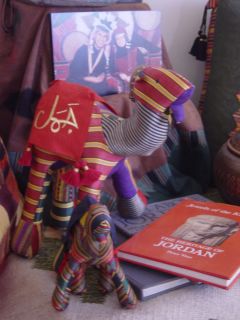Source:
http://www.ibiblio.org/prism/mar98/donning.htmlDonning the Hijab
(how not to be a sex object)
by Samuel Cole
Smetime in 1987 my sister, an ardent feminist with a degree in civil engineering, converted to Islam. She now lives in Lahore, Pakistan where she is a full-time Muslim wife and mother of five—soon to be six. As is required by her adopted Qur'an, she stops all activities to pray five times each day; and when she goes out in public she covers herself from head to toe in the hijab.
The term "hijab" comes from the Arabic word "hijaba," which means to hide from view. It is the long dress and veil worn by many Muslim women with the function of distinguishing them from non-Muslims, reminding them of their Islamic faith, and concealing them from the public view of males. In many of the more traditional Muslim societies women tend to remain outside the public sphere of men, devoting themselves to child rearing and taking care of the home. In part because of this apparent restriction from the public realm, many Americans see the Muslim hijab as a symbol of female oppression.
Despite this perception, Islam is growing rapidly in America—and female converts outnumber males four to one. Indeed, according to my sister the hijab is not a symbol of oppression, but is instead a symbol of liberation. Naheed Mustafe, a Canadian woman who converted to Islam, writes that "young Muslim women are reclaiming the hijab. . . to give back to women the ultimate control over their bodies." Yet to most Americans this is a strange assertion. How can a law that restricts a woman's dress be liberating?
To Muslims the answer is easy. The Islamic tradition of hijab frees women from being perceived primarily as sexual objects. "[Non-Muslim] women are taught from early childhood that their worth is proportional to their attractiveness," writes Mustafe. It's not hard to understand this: leafing through the ads of any woman's magazine, even a male reader can sense the incredible pressure on women to conform to some ever-changing and abstract image of female beauty. Is it any wonder that American women spend billions of dollars on hair and beauty products; or that they subject themselves to plastic surgery, drugs, and diets; or that in despair they fall into neurotic cycles of anorexia and bulimia? It is the pursuit of a mirage—one that degrades and sickens the pursuers.
The hijab liberates a Muslim woman from this insidious oppression. She need not concern herself with her hair or makeup before she goes out. Underneath her hijab she can remain if she so wishes, simply herself: unshaved, unpainted, unplucked, or even a little overweight. All this without having to worry about what others think of her. The tradition of hijab, writes Mustafe, is "simply a woman's assertion that judgment of her physical person is to play no role whatsoever in social interaction." Since a Muslim woman is invisible behind her veil, she can be appreciated only for her intellectual qualities. Thus the importance of her physical appearance becomes subordinate to her intelligence and personality.
But the sacrifice of health (and self esteem) in a futile pursuit of physical attractiveness is not the worst effect of sexual objectification. Societies that view women as sexual objects have a horrendous rate of violence toward women. In the United States, one out of every four women will be sexually assaulted at some time in her life. And even in relatively non-violent Canada, one woman is assaulted every six minutes.Women in our society live with the awareness that they must always be cautious of dark alleys and fearful of strangers. This is true oppression, a type that stems directly from the perception of women as sexual objects.
In the few societies that closely adhere to the Qur'an—and many repressive Islamic regimes do not—this sort of violence toward women is quite low. In 1990 the number of reported rapes in Egypt, a relatively westernized Islamic society with a secular government, was only 17 (Israel reported 369 rapes that same year). And my sister has told me that as a Muslim woman, she feels a respect and security on the streets of Pakistan that she had never felt in 30 years of living in America. It does seem hard to ignore the fact that many Islamic women enjoy a level of protection and respect that is unheard of in the West. In some countries this is no doubt in part the result of Islamic law that imposes draconian punishment on offenders. But extreme enforcement of religious law is not practiced in moderate Islamic countries such as Egypt or Pakistan; and there it seems Muslim tradition alone protects the dignity of women.
Nevertheless, Islam and its tradition of hijab can seem an extreme solution to the sexual objectification of women. Can't society simply be changed through more education? Or perhaps through encouraging men to practice some self-restraint? In fact this has been a goal of the women's movement for years. But although there has been some success at increasing career and educational opportunities for women, the oppression of women continues unabated. One only needs to peruse the horror section of the local video store to see that the most common victims of violence portrayed in popular films are women. And not surprisingly statistics in the United States point to more violence directed at women, not less.
The problem in western society, as some Muslim writers see it, is that predominately Judeo-Christian cultures have no convention of equality between men and women. Instead, these traditions hold Eve to be ultimately responsible for original sin and the downfall of man. The story in Genesis is a cornerstone in the foundation of our culture. As such, it has institutionalized an essentially inferior status for women. This is not so in the tradition of Islam: Eve is not blamed for tempting Adam. Together they sinned, together they are guilty, and together they both begged for (and received) forgiveness from God. It is true that Islam holds women and men to be different in the most integral qualities. But unlike Judeo-Christian doctrine, the Qu'ran puts women and men on equal footing before God and thus as equally, and innately, valuable to society.
Unfortunately, many of us see Islam as a religion of suicidal bombers or of bearded zealots intent on returning us all to a cultural stone-age. But this image is perhaps unfair. All religions have their own fair proportion of crazies. Islam, however, is the largest and fastest growing of the world's monotheistic religions, and has (quite properly) more than most. Still, the Muslims have something to offer for women. Pierre Craibites (an American judge) writes: "Muhammad, 1300 years ago, assured to the mothers, wives and daughters of Islam a rank and dignity [still] not generally assured to women by the laws of the West."
The conversion of my sister to Islam was a shock and then a mystery to me for many years. It did not seem possible for an intelligent feminist woman to, without coercion, suddenly chuck her ideals and embrace the religion of the misogynist Ayatollahs. Within my family the subject is beyond the bounds of rational discussion, and it is only from my sister's very recent letters that I may have finally acquired an understanding of her unique brand of feminism: You see, in adopting Islam she has rejected a culture that assigns value to a person based on a masculine ideal of success. In exchange she has adopted a culture where she is valued as an equal. . . for no other reason than that she is a woman.
Samuel Cole is a freelance writer living in Carrboro.



































